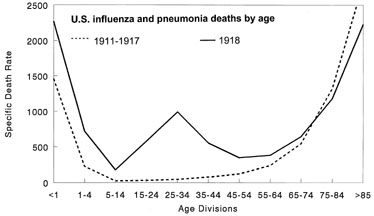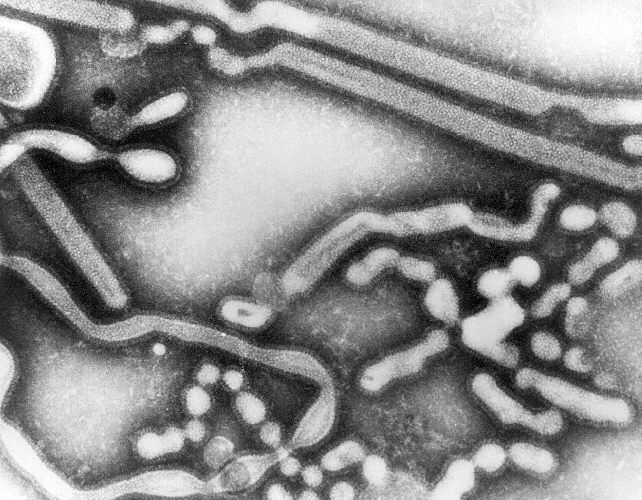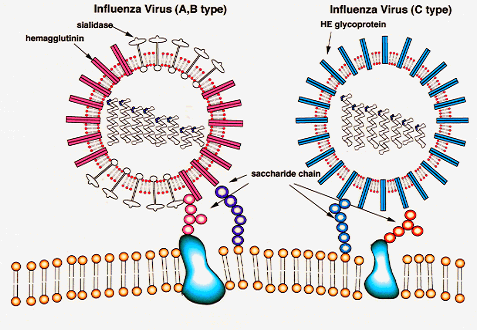1918 Influenza Pandemic: What
Happened?
1918 "Spanish" flu Distinguishing features:
- most deaths in U shape curve as function of age (very young and very old
die); 1918 flu had W shape with high death rate among 15-34 year olds.
- Mortality rate high (2.5%) compared to 0.1% for modern epidemics
- Isolated communities like Alaskan Eskimos mortality rates above 70% (most
in 15-34 year olds).

Finding Virus Samples for Study
In 1951, scientists from the University of Iowa exhumed
bodies of victims of the 1918 flu that had been buried in permafrost in Teller
Mission, an Inuit fishing village on the Seward Peninsula of Alaska. This
village, now called Brevig Mission, suffered extremely high mortality rates
during the influenza pandemic in November 1918. According to available records,
influenza spread through the village in about 5 days and killed 72 people,
representing about 85% of the adult population.
During the 1951 expedition, samples of lung, brain, and
other organs were taken for histologic analyses and viral culture. All attempts
to culture live influenza virus from these specimens were unsuccessful.
Molecular genetic analyses of the samples were impossible at that time--indeed,
the double-stranded structure of DNA, with its implications for molecular
genetics, was not determined until 1953.
In 1995, my laboratory initiated a project to characterize
the 1918 influenza virus genetically using archival formalin-fixed,
paraffin-embedded autopsy tissues of 1918 flu victims stored in the National
Tissue Repository of the Armed Forces Institute of Pathology (AFIP). A search of
the archives revealed over 70 autopsy cases of U.S. soldiers who died of
influenza pneumonia in the fall of 1918. We used techniques to isolate RNA that
had been optimized for fixed tissue specimens based on previous studies.
http://www.asmusa.org/memonly/asmnews/jul99/feature1.html
Origin and Evolution of the 1918 "Spanish" influenza virus Hemagglutinin gene.
Reid, A. et al. PNAS, 96, pg 1661 (1999)

http://www.immunize.org/images/ca.d/ipcd1861/img0024.htm

http://phil.cdc.gov/Phil/detail.asp?id=279

http://web.uct.ac.za/depts/mmi/jmoodie/flu2life.gif
3 types of flu viruses: A, B, and C. 1918 was A. Two major
proteins: hemagglutinin (HA) and neuraminidase. HA responsible for virus
binding

http://www.gifu-u.ac.jp/~kassei/influenza%20virus.gif

http://www.omedon.co.uk/influenza/beans/influenza%20virus.jpg
Hemaglutinin (HA) responsible for:
- virus binding to host receptor
- internalization of virus
- membrane fusion of internalized virus endosome
HA:
- Is most abundant protein on viral surface (as surmised by antibody
formation)
- 15 avian and mammalian variants (serotypes) have been identified (based on
antibody studies); only 3 adapt to humans in last 100 yr, giving
pandemic strains H1 (1918), H2 (957) and H3 (1968)
- 3 recent avian variants (H5, H7, and H9) jump directly to humans recently;
but low human to human transmissibility.
- What if avian strain jump with high human transmissibility?
Structure HA:
- mature form is homotrimer, MW 220,000; multiple glycosylation sites.
- Each monomer synthesized as single polypeptide chain precursor (HA0) that
is cleaved into HA1 and HA2 subunits by trypsin-like enzyme in epithelial
cells of lung.
- Structure known for human (H3), swine (H9), avian (H5) subtypes. Now
piece together structure of extinct 1918 HA, second human subtype: H2).
 Chime Model:
Hemagglutinin antigen
Chime Model:
Hemagglutinin antigen
 Chime Model:
Neuraminidase
Chime Model:
Neuraminidase
HA binding site:
- bind to sialic acid residues on cell surface glycoproteins
- sialic acid usually α2,3 or
α2,6 linked to terminal Gal on N-linked glycoproteins. Preference
correspond to species specificity
- 15 subtypes found in avian influenza bind preferentially to Gal (α2,3)Sia
which predominates in avian GI tract where viruses replicate
- swine influenza HA bind to
α2,6 and some
α2,6 both of which found in swine.
- Human virus of H1, H2, and H3 subtype (cause 1918, 957, and 1968
pandemics) recognize α2,6 Sia, major form in
human respiratory tract.
Links:
For cross-species transfer
need changes in binding specificity.
- for human virus H2 and H3, need minimum 2 changes in receptor
binding site: N226L, and G228S to shift from avian to human receptor binding.
- for human H1, can bind to human receptor w/o change in N226 and G228.
- What the is basis for H1 binding to human receptor?
Findings:
1918 HA has:
Structure Files:
- 1918 Human H1 (1rd8.pdb)
- Human H3 (2hmg)
- Avian H5 (1jsm)
- Swine H9 (1jsd)
Reference:
Stevens, J. et al. Structure of the Uncleaved Human H1 Hemagglutinin from the
Extinct 1918 Influenza Virus. Science, 303, pg 1866 (2004)
Gamblin, S. The Structure and Receptor Binding Properties
of the 1918 Influenza Hemagglutinin. Science, 303, pg 1838 (2004)
Questions:
How travel/Where originated?
- How did the virus get to Europe when it had
been dead in Kansas for awhile? Did it live in a host with out affecting
them?
- Do they know how this strand of the flu
started?
- What organism would have been
in the manure that is not killed by being burned? Is it similar to the one
which causes mad cow disease?
- If the war hadn't been going on would the
virus have spread as rapidly and as vastly? Would response to it have been
different? 22-25, Beth R
-
Did the flu get passed to
people from other countries because of the war and our troops carrying the
virus?
Who got it?
- Why were people 21-29 the strongest, the most
likely to die fromt he flu?
- Why weren't
the robust young soldiers more immune to influenza than the young, old, and
weak? 9-11 Gail A
- Were civilians in Europe as greatly affected
by this influenza as the population of the U.S.? (6-9 ES)
- Why or how
was it that influenza killed primarily people 21-29 rather then then the young
and old who tend to be more prone to illness?
- Why weren't the very young and elderly most
suspectible to the virus? What made them more immune?
-
Why were some people more
susceptible to getting influenza than others and also, some able to recover
from it?
How did it end?
- How did the flu just go away? 1-5 molly
- If soil were dug up today
where the bodies were buried, would the virus still be alive in that area?
- How did the
virus suddenly tire out and end the spread of influenza? Was it that everyone
had been exposed to it and that all that were going to die from it had already
died?
- How was it possible for the bacteria causing
influenza to leave as quickly as it came if no vaccine was ever found to
prevent it?
-
How long could the flu live
in a dead body and be able to infect other people?
Virus/Disease Biology
- Do scientists know what the influenza virus
looks like, what its makeup is? Can they find this makeup or use it to
"solve" this virus and prevent it from causing great destruction again? What
progress is being made in the study of the influeza virus?
- What physiological change occurs in the body
(difference in cells, function of cells, etc.) when fluid collects in the
lungs? Could this lead to the identification of the flu virus and how it
works? 26-28 Margaret G
-
Seeing that the HIV-virus is
a s mutable as influenza, and given that it is constantly being transmitted
from one person to the next; is it possible for the HIV-virus to change from
Blood-borne to airborne?
Protection/Treatment
- Does a flu shot protect against all strains of
the flu? And if so, how does it accomplish this?
- Do people
know what some of the contributing factors are that started the outbreak?
- What
were some of the other folk remedies that people tried, and were people ever
able to make medicines that worked?
-
Was there anything that
could have been done that we know of now that would have helped control the
outbreak.
-
If the scientists knew that
the flu was a virus did they have the technology to produce a vaccine
- With the advancement of technology since 1918,
has a vaccine ever been discovered to prevent future cases of influenza, or
could there be an outbreak in the future with the same or worse results?
19-21 Maggie M
-
During the flu epidemic,
many people where trying to capitalize on it by marketing many different
quick-fix remedies that were supposed to either prevent or eliminate the onset
of the flu. Do you see any similarities between the capitalizing on epidemics
in America today as in those times? Hint: Obesity. 29-31 Chad H
Big Questions
-
Would it have been immoral
to not send the troops to Germany so the virus would not be spread to other
people 12-14 Lindsay
- Does an epidemic like this or others in
history like the Black Plague, need to occur for some reason? Is there some
philosophical answer why nature permits these epidemics to occur? Is it for
population control, human realization of our limited power, understanding of
being thankful when times are good? Is there some underlying reason or
purpose to epidemics? Do they just occur by chance or is there some
underlying force deemed against humanity?
-
How likely is this to happen
again in the future, and could we have a vaccine to combat it?32-35 Cheri S.
Symptoms
- How can
someone's temperature rise so high that they don't die but there hair changes
color?
- How was the
virus able to spread so quickly throughout the body without symptoms being
shown until it was too late?15-19, Katie A
- Why did the fever from influenza in the film
cause people's hair to turn to white?
- How does a high fever make one's hair turn
white?
-
When people started getting
the influenza virus in the year 1918, they usually died of pneumonia; however
today when people get the flu they usually do not die, but just have a
temporary fever and tiredness. What can account for the difference in response
to the virus between people in 1918 and people in the year 2000?
Links:







![]() Chime Model:
Hemagglutinin antigen
Chime Model:
Hemagglutinin antigen![]() Chime Model:
Neuraminidase
Chime Model:
Neuraminidase